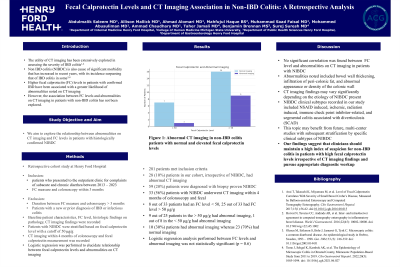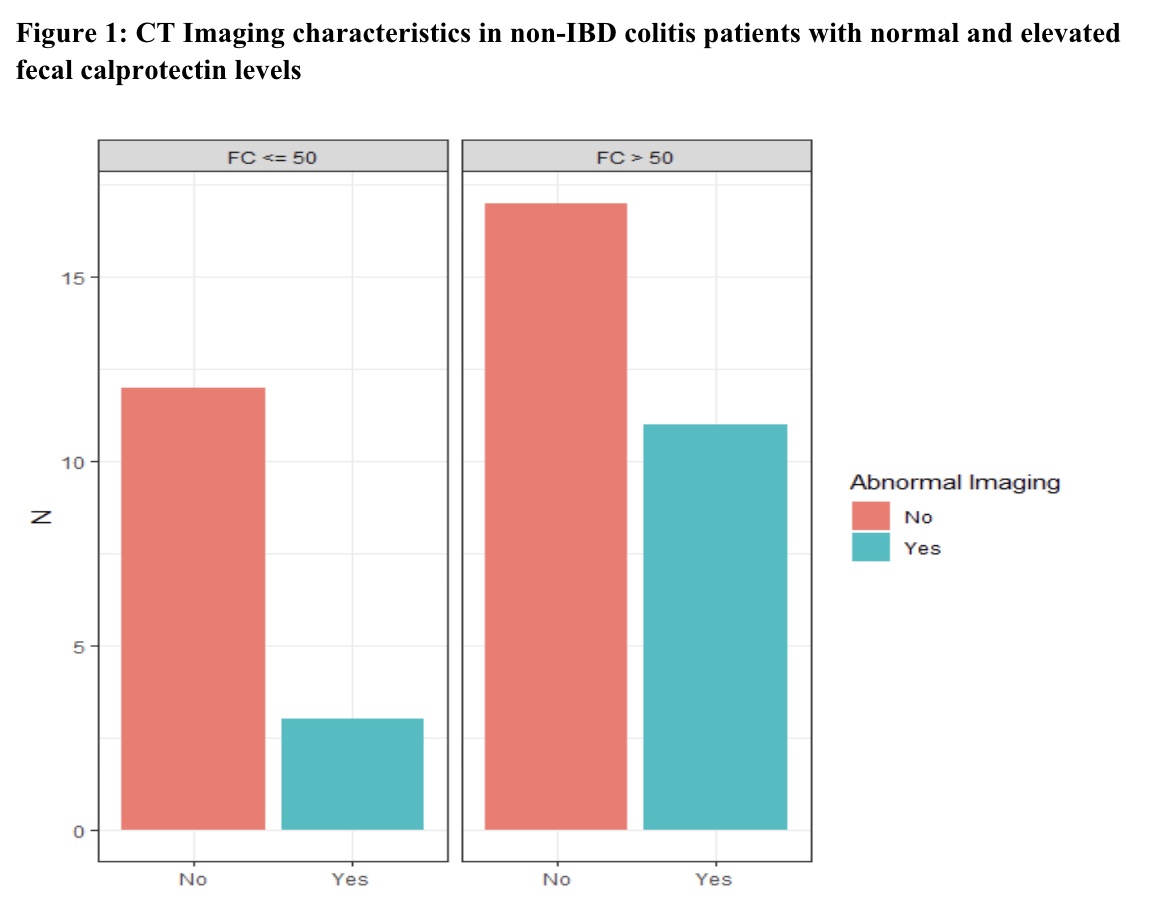Sunday Poster Session
Category: Colon
P0223 - Unraveling the Role of Fecal Calprotectin and CT Imaging in Non-IBD Colitis
Sunday, October 27, 2024
3:30 PM - 7:00 PM ET
Location: Exhibit Hall E

Has Audio

Abdulmalik Saleem, MD
Henry Ford Health
Flushing, MI
Presenting Author(s)
Abdulmalik Saleem, MD1, Allison N. Malick, MD1, Ahmad Alomari, MD2, Mahfujul Haque, 3, Muhammad Saad Faisal, MD1, Mohammed Abusuliman, MD1, Ammad Javaid. Chaudhary, MD1, Taher Jamali, MD2, Benjamin Brennan, MS1, Suraj Suresh, MD1
1Henry Ford Health, Detroit, MI; 2Henry Ford Hospital, Detroit, MI; 3Michigan State University College of Human Medicine, Troy, MI
Introduction: Current literature details the utility of computed tomography (CT) imaging and its correlation with pathologic inflammation in inflammatory bowel disease (IBD). Higher fecal calprotectin levels in IBD patients have been associated with a greater likelihood of abnormalities noted on CT imaging. This relationship has not been explored in non-IBD colitis. We seek to elucidate the correlation between abnormalities on imaging and histologic colitis in the context fecal calprotectin (FC) with the hopes of commenting on the utility of CT imaging in assessing disease activity in non-IBD colitis.
Methods: This was a retrospective study of clinic patients at a tertiary care medical system who presented with subacute or chronic diarrhea between 2013 – 2023. Patients who had an abnormal FC test during their clinic visit followed by a colonoscopy within 3 months of this test result were included. Patients with a new or prior diagnosis of IBD or infectious colitis were excluded. Baseline patient characteristics, CT imaging findings within a 4-month window, FC levels, histologic, and endoscopic findings on colonoscopy were collected from medical records. Imaging findings were compared between patients with high ( >50 μg/g) and normal (< 50 μg/g) FC levels in patients with histologically proven non-IBD colitis.
Results: 282 patients met the inclusion criteria, of which 43 patients were diagnosed with non-IBD colitis based on histology. These 43 patients were stratified into two cohorts based on FC levels and the presence or absence of colitis on imaging. 28 patients had an elevated FC while 14 patients had normal FC. Of these 43 patients, 28 underwent CT imaging between their clinic visit and colonoscopy. 11 of these patients had abnormal CT imaging demonstrating colitis while 17 patients had normal imaging. A logistic regression analysis was performed to explore the relationship between FC and abnormal CT imaging which revealed no statistically significant correlation (p = 0.6). Figure 1 shows the distribution of normal and abnormal imaging findings in each cohort.
Discussion: Our study demonstrates no significant relationship between FC levels and CT imaging findings in patients with non-IBD colitis. This finding contrasts with studies showing an association between FC and abnormal imaging in patients with IBD. Clinicians should maintain high suspicion for non-IBD colitis in patients with high FC levels regardless of normal CT imaging and pursue appropriate diagnostic workup when otherwise indicated.

Disclosures:
Abdulmalik Saleem, MD1, Allison N. Malick, MD1, Ahmad Alomari, MD2, Mahfujul Haque, 3, Muhammad Saad Faisal, MD1, Mohammed Abusuliman, MD1, Ammad Javaid. Chaudhary, MD1, Taher Jamali, MD2, Benjamin Brennan, MS1, Suraj Suresh, MD1. P0223 - Unraveling the Role of Fecal Calprotectin and CT Imaging in Non-IBD Colitis, ACG 2024 Annual Scientific Meeting Abstracts. Philadelphia, PA: American College of Gastroenterology.
1Henry Ford Health, Detroit, MI; 2Henry Ford Hospital, Detroit, MI; 3Michigan State University College of Human Medicine, Troy, MI
Introduction: Current literature details the utility of computed tomography (CT) imaging and its correlation with pathologic inflammation in inflammatory bowel disease (IBD). Higher fecal calprotectin levels in IBD patients have been associated with a greater likelihood of abnormalities noted on CT imaging. This relationship has not been explored in non-IBD colitis. We seek to elucidate the correlation between abnormalities on imaging and histologic colitis in the context fecal calprotectin (FC) with the hopes of commenting on the utility of CT imaging in assessing disease activity in non-IBD colitis.
Methods: This was a retrospective study of clinic patients at a tertiary care medical system who presented with subacute or chronic diarrhea between 2013 – 2023. Patients who had an abnormal FC test during their clinic visit followed by a colonoscopy within 3 months of this test result were included. Patients with a new or prior diagnosis of IBD or infectious colitis were excluded. Baseline patient characteristics, CT imaging findings within a 4-month window, FC levels, histologic, and endoscopic findings on colonoscopy were collected from medical records. Imaging findings were compared between patients with high ( >50 μg/g) and normal (< 50 μg/g) FC levels in patients with histologically proven non-IBD colitis.
Results: 282 patients met the inclusion criteria, of which 43 patients were diagnosed with non-IBD colitis based on histology. These 43 patients were stratified into two cohorts based on FC levels and the presence or absence of colitis on imaging. 28 patients had an elevated FC while 14 patients had normal FC. Of these 43 patients, 28 underwent CT imaging between their clinic visit and colonoscopy. 11 of these patients had abnormal CT imaging demonstrating colitis while 17 patients had normal imaging. A logistic regression analysis was performed to explore the relationship between FC and abnormal CT imaging which revealed no statistically significant correlation (p = 0.6). Figure 1 shows the distribution of normal and abnormal imaging findings in each cohort.
Discussion: Our study demonstrates no significant relationship between FC levels and CT imaging findings in patients with non-IBD colitis. This finding contrasts with studies showing an association between FC and abnormal imaging in patients with IBD. Clinicians should maintain high suspicion for non-IBD colitis in patients with high FC levels regardless of normal CT imaging and pursue appropriate diagnostic workup when otherwise indicated.

Figure: CT Imaging characteristics in non-IBD colitis patients with normal and elevated fecal calprotectin levels
Disclosures:
Abdulmalik Saleem indicated no relevant financial relationships.
Allison Malick indicated no relevant financial relationships.
Ahmad Alomari indicated no relevant financial relationships.
Mahfujul Haque indicated no relevant financial relationships.
Muhammad Saad Faisal indicated no relevant financial relationships.
Mohammed Abusuliman indicated no relevant financial relationships.
Ammad Chaudhary indicated no relevant financial relationships.
Taher Jamali indicated no relevant financial relationships.
Benjamin Brennan indicated no relevant financial relationships.
Suraj Suresh indicated no relevant financial relationships.
Abdulmalik Saleem, MD1, Allison N. Malick, MD1, Ahmad Alomari, MD2, Mahfujul Haque, 3, Muhammad Saad Faisal, MD1, Mohammed Abusuliman, MD1, Ammad Javaid. Chaudhary, MD1, Taher Jamali, MD2, Benjamin Brennan, MS1, Suraj Suresh, MD1. P0223 - Unraveling the Role of Fecal Calprotectin and CT Imaging in Non-IBD Colitis, ACG 2024 Annual Scientific Meeting Abstracts. Philadelphia, PA: American College of Gastroenterology.
